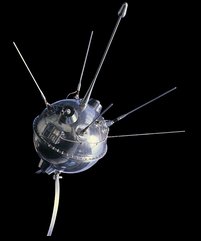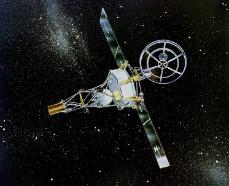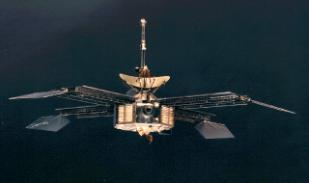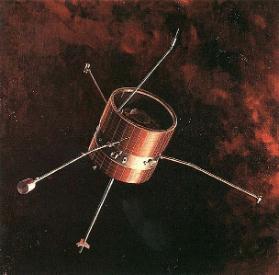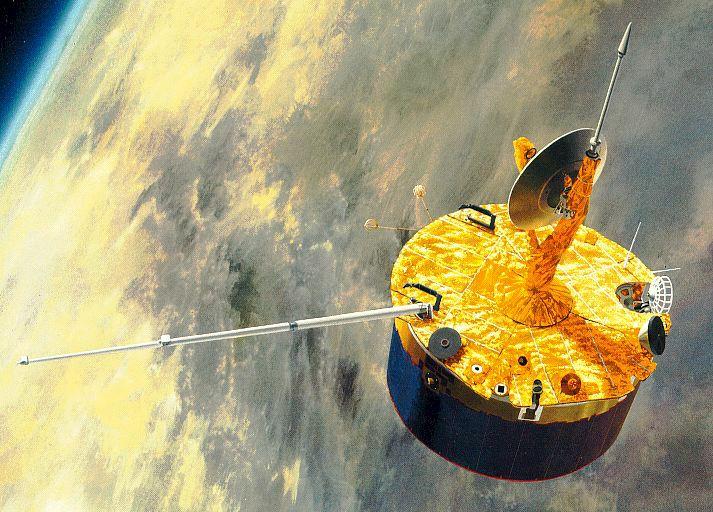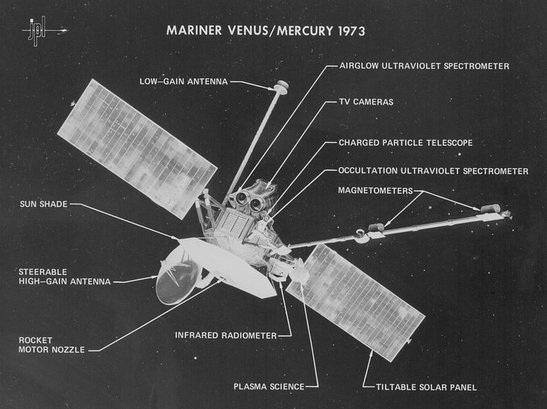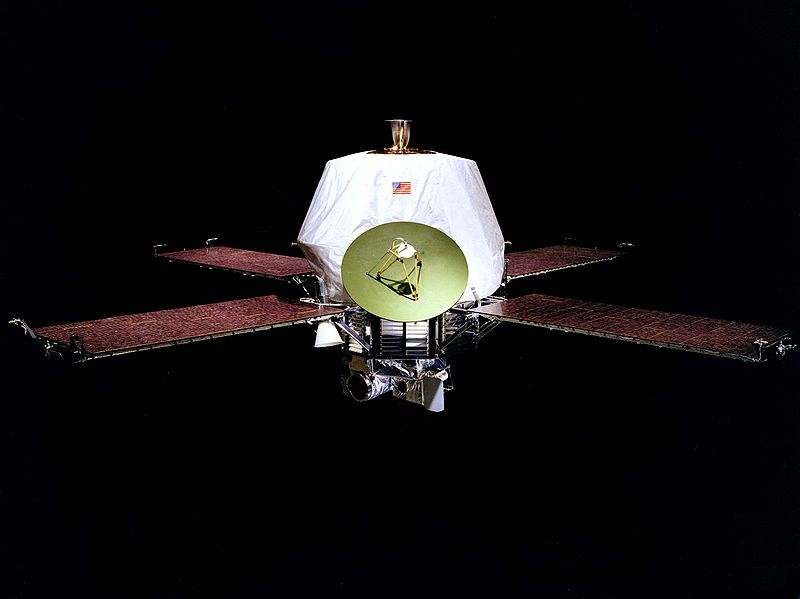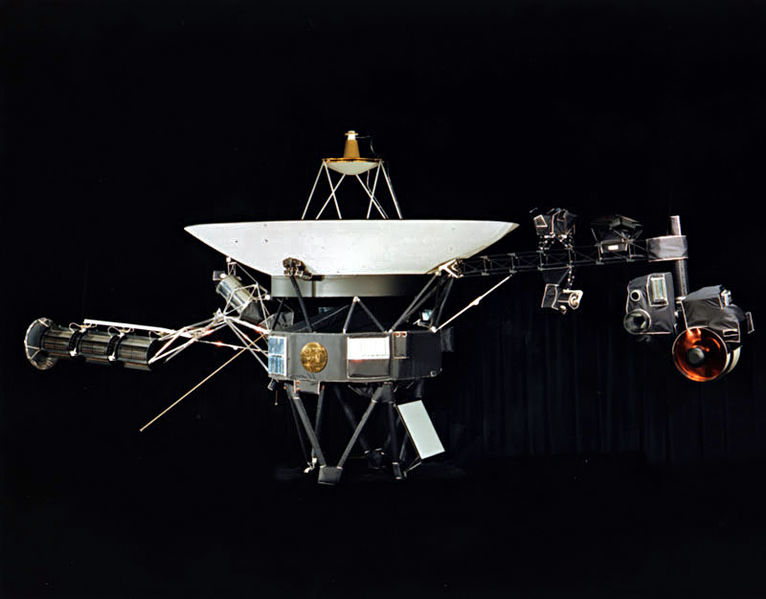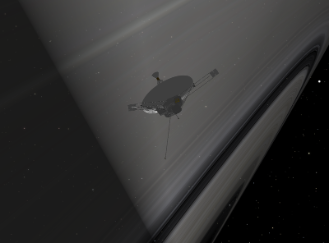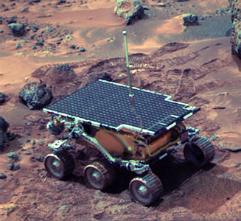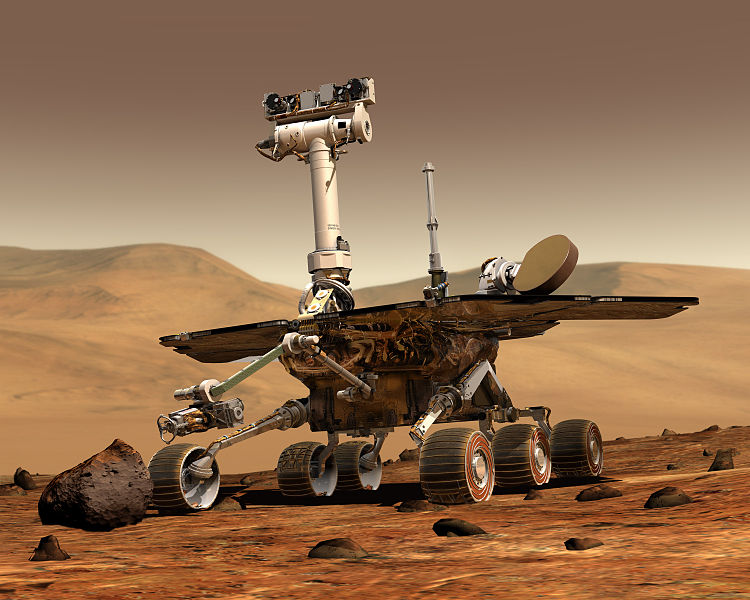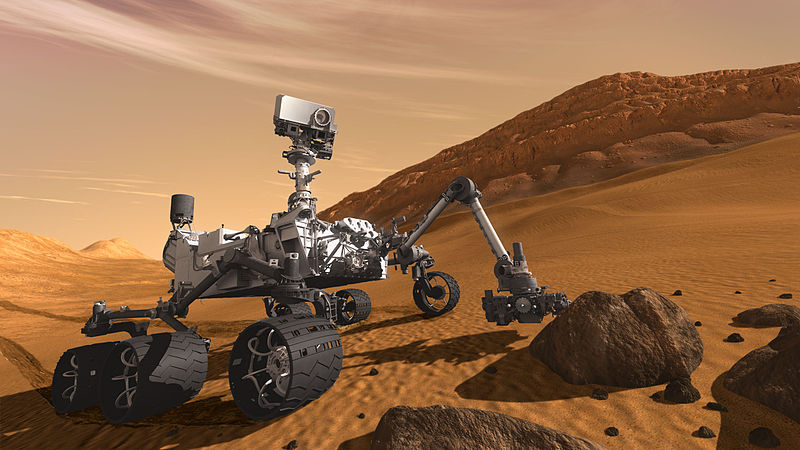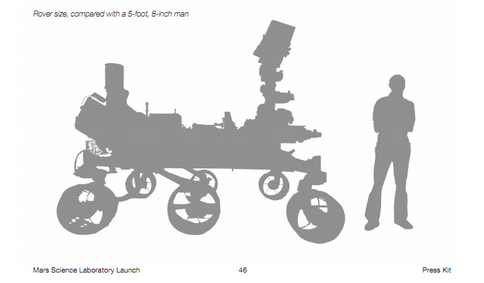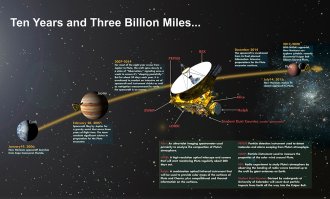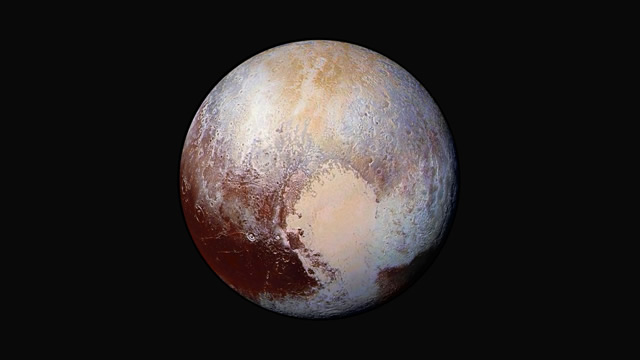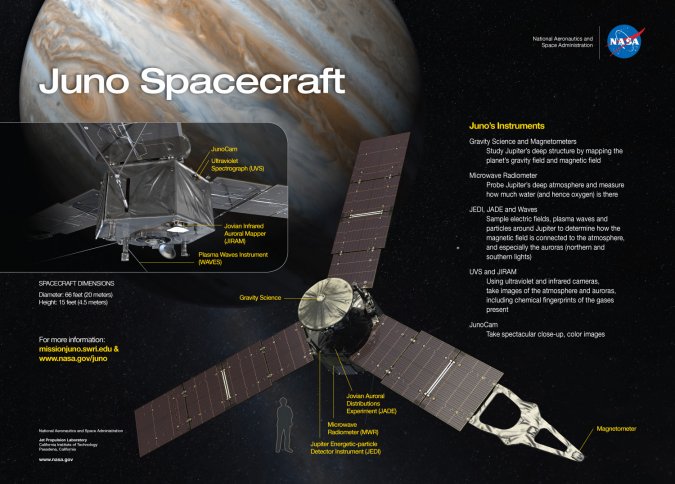Although humans have not yet ventured beyond the Moon, our agents - automated space probes - have gone much farther. Robotic explorers have visited all the planets, including Pluto, and have also surveyed dozens of satellites and a handful of minor bodies. During their travels, they have transformed our view of the Solar System, revealing other worlds almost as complex as our own.
The first probe to leave Earth's influence and go into its own orbit around the Sun was Russia's Lunik 1 (pictured left, also known as Luna 1), which in 1959 missed its intended target, the Moon, and thus became the first interplanetary probe by accident. This however, was soon followed by more deliberate efforts. |
|
The Mariner 2 spacecraft (pictured above) weighed just 202kg (445lb), |
Mariner 4 (above) was more compact than Mariner 2, but 60kg (130lb) heavier. As the Sun's energy is weaker out at the Martian orbit, it required an array of four solar panels, compared to just two on Mariner 2. |
|
NASA's Pioneer probes, including Pioneer 6 (above), and the later Pioneer Venus (below), paved the way for automated space exploration |
Being closer to the Sun, both Venus and Mercury are travelling faster than the Earth, so any probe must pick up speed in order to enter their orbits. Nevertheless, an armada of spacecraft overcame this technical challenge and visited Venus in the years after the first fly-by. Several Soviet Venera probes attempted to land on the hostile surface, only to be destroyed during descent. In 1967, Venera 4, equipped with tank-like shielding, sucessfully sent back signals from Venus's surface. It was eight years later that Venera 9 returned the first pictures of the Venusian landscape. Both NASA and the Soviets also launched orbiters to survey the planet with radar and released atmospheric probes. In 1989, Magellan, a NASA orbiter equipped with sophisticated radar, studied the planet in unprecedented detail over four years. Mercury's orbital speed presents a larger problem: to date, only Mariner 10 has imaged its surface. Mariner 10, aka Mariner Venus (above) followed a flight path that allowed it to make three close aproaches to Mercury in successive orbits. Even then it could only photograph half the surface. |
The first flybys of Mars were remarkable achievements, but were unfortunate in their flight paths. Three US probes returned pictures of 10 per cent of the Martian surface and yet missed all the evidence of volcanism and water that makes the planet so fascinating. NASA's luck changed in 1971, when Mariner 9 (pictured left) became the first spacecraft to orbit Mars. It carried out a photographic survey that revealed the 'Valles Marineris' system, the towering volcanoes of the Tharsis region, and the first signs of liquid-eroded canyons. With interest in the Red Planet rejuvenated, NASA's Viking mission then launched twin spacecraft to Mars, each consisting of an orbiter and a lander. The Viking orbiters created the first detailed photographic atlas of Mars, while the landers sent back pictures and weather reports from the surface, and also carried out a number of experiments, including a controversial test for microbial life.
|
The 1970s presented a rare opportunity, as Jupiter, Saturn, Uranus, and Neptune came into n alignment that would allow a spacecraft to travel from one to another using a "gravitatinoal slingshot" effect. A so-called "Grand Tour" mission would take little more than a decade. In 1977, NASA launched Voyagers 1 and 2, (two identical probes) initially targeted at just Jupiter and Saturn. Voyager 1 (pictured at right) passed Jupiter in March 1979 and Saturn in November 1980, making the first close approach to its moon Titan. Voyager 2 followed a few months later, and, once Voyager 1 had accomplished its mission, NASA technicians put their backup plan into action, swinging the second probe around Saturn onto a course for Uranus, in 1986, and Neptune in 1989. This extremely successful mission offered us our first glimpses of the cold outer giants, their moons and rings. Both spacecraft are still traveling beyond Pluto, even towards inter-stellar space beyond the Solar System. |
The voyagers were preceded by Pioneer 10, which reached Jupiter in 1973, and Pioneer 11 (left), which reached Saturn in 1979. The images they were able to beam back to Earth were the best of the time but were soon bettered by Voyagers' images. |
Despite the success of the Viking landers, probes did not return to Mars until the late 1990s, following a series of ill-fated Soviet missions. In 1997, NASA's Mars Global Surveyor swung into orbit around the planet, equipped with the latest cameras, while a lander, Mars Pathfinder, deployed a wheeled rover called 'Sojourner' (pictured left), which sampled rocks and soil. Many new spacecraft followed this advance guard, with each new discovery making the possibility of life on Mars seem more plausible. |
A number of artificial satellites now orbit the planet, using remote-sensing techniques to probe the Martian subsoil, while a pair of robust Mars Exploration Rovers, 'Spirit' and 'Opportunity', (one is shown on the left) have discovered the clinging proof that Mars had widespread and long-lived oceans in its past. More missions are being planned to further the search for existing water and life on Mars. |
Another NASA mission called Mars Science Laboratory is currently underway after having landed another rover, called 'Curiosity', on the red planet. This is following on from a successful launch aboard an Atlas V rocket on Nov 26 2011. One mission objective is to determine whether Mars can in the future, or has been in the past able to, support life. The Curiosity rover (right) is about five times larger than the Spirit or Opportunity rovers and is carrying ten times more in terms of the mass of scientific instruments.
|
New Horizons is an interplanetary space probe that was launched as part of NASA's New Frontiers program.
Engineered by the Johns Hopkins University Applied Physics Laboratory (APL) and the Southwest Research Institute (SwRI),
with a team led by S. Alan Stern, the spacecraft was launched to study Pluto, its moons and the Kuiper belt,
performing flybys of the Pluto system and one or more other Kuiper belt objects (KBOs). New Horizons is the result of many years of work on missions to send a spacecraft to Pluto, starting in 1990 with Pluto 350, with Alan Stern and Fran Bagenal of the "Pluto Underground", and in 1992 with the Jet Propulsion Laboratory's Pluto Fast Flyby; the latter inspired by a USPS stamp that branded Pluto as "Not Yet Explored".
|
|
|
|
|
Main source: DK illustrated encycolpedia of the universe. Most photos courtesy of Wikipedia

For the latest up-to-date information about Solar System exploration missions,
please visit Emily Lakdawalla's blog at the The Planetary Society
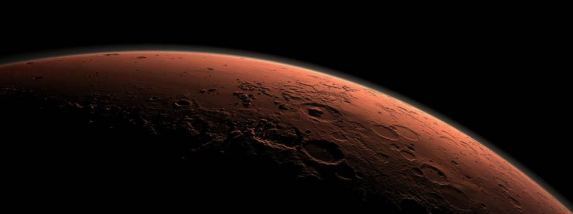

The twin Voyager 1 and Voyager 2 spacecraft continue exploring where nothing from Earth has ever flown before. + years after their 1977 launches, they each are much farther away from Earth and the Sun than Pluto. Read more here...
This video is a shot of our planet Earth from NASA's Voyager1 spacecraft, from 3.7 billion miles away, on its voyage beyond the outer bounds of the Solar System. Narration is by the late astronomer Carl Sagan
OUR PALE BLUE DOT...
"From this distant vantage point, the Earth might not seem of any particular interest. But for us, it's different. Consider again that dot. That's here. That's home. That's us. On it everyone you love, everyone you know, everyone you ever heard of, every human being who ever was, lived out their lives. The aggregate of our joy and suffering, thousands of confident religions, ideologies, and economic doctrines, every hunter and forager, every hero and coward, every creator and destroyer of civilization, every king and peasant, every young couple in love, every mother and father, hopeful child, inventor and explorer, every teacher of morals, every corrupt politician, every "superstar," every "supreme leader," every saint and sinner in the history of our species lived there – on a mote of dust suspended in a sunbeam.
The Earth is a very small stage in a vast cosmic arena. Think of the rivers of blood spilled by all those generals and emperors so that in glory and triumph they could become the momentary masters of a fraction of a dot. Think of the endless cruelties visited by the inhabitants of one corner of this pixel on the scarcely distinguishable inhabitants of some other corner. How frequent their misunderstandings, how eager they are to kill one another, how fervent their hatreds. Our posturings, our imagined self-importance, the delusion that we have some privileged position in the universe, are challenged by this point of pale light. Our planet is a lonely speck in the great enveloping cosmic dark. In our obscurity – in all this vastness – there is no hint that help will come from elsewhere to save us from ourselves.
The Earth is the only world known, so far, to harbor life. There is nowhere else, at least in the near future, to which our species could migrate. Visit, yes. Settle, not yet. Like it or not, for the moment, the Earth is where we make our stand. It has been said that astronomy is a humbling and character-building experience. There is perhaps no better demonstration of the folly of human conceits than this distant image of our tiny world. To me, it underscores our responsibility to deal more kindly with one another and to preserve and cherish the pale blue dot, the only home we've ever known."
—Carl Sagan, Pale Blue Dot: A Vision of the Human Future in Space
